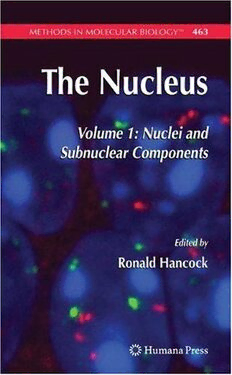Download The Nucleus: Volume 1: Nuclei and Subnuclear Components PDF Free - Full Version
Download The Nucleus: Volume 1: Nuclei and Subnuclear Components by Santiago Schnell, Ronald Hancock (auth.), Ronald Hancock (eds.) in PDF format completely FREE. No registration required, no payment needed. Get instant access to this valuable resource on PDFdrive.to!
About The Nucleus: Volume 1: Nuclei and Subnuclear Components
Although our understanding of the structure and activities of the cell nucleus and of the nanomachines which it contains is increasing rapidly, much remains to be learned. The application and continuing development of the new, powerful biochemical and biophysical methodologies described here are essential in this quest. In The Nucleus, researchers from more than forty leading international laboratories describe state-of-the-art methods for isolating nuclei and their components and for studying their structure and activities, including some pathology-associated features. Volume I: Nuclei and Subnuclear Structures presents an overview of features of the intranuclear environment, followed by the most recent procedures for isolating nuclei from a wide range of cell types including muscle cells, yeast, oocytes, cells with polytene nuclei, Arabidopsis, trypanosomes, and dinoflagellates. The latest methods are described for isolating and working with nucleoli, constitutive heterochromatin, pathology-associated inclusions, and chromatin and for examining glycosylation, sumoylation, and ADP-ribosylation of nuclear proteins. Written in the highly successful Methods in Molecular Biology™ series format, chapters contain lists of necessary materials and reagents, readily reproducible protocols, and tips for troubleshooting and avoiding known pitfalls.The Nucleus, Volume I: Nuclei and Subnuclear Structures is an essential reference for scientists who are working on our rapidly growing understanding of the cell nucleus and its activities.
Detailed Information
| Author: | Santiago Schnell, Ronald Hancock (auth.), Ronald Hancock (eds.) |
|---|---|
| Publication Year: | 2008 |
| ISBN: | 9781597454063 |
| Pages: | 328 |
| Language: | English |
| File Size: | 3.658 |
| Format: | |
| Price: | FREE |
Safe & Secure Download - No registration required
Why Choose PDFdrive for Your Free The Nucleus: Volume 1: Nuclei and Subnuclear Components Download?
- 100% Free: No hidden fees or subscriptions required for one book every day.
- No Registration: Immediate access is available without creating accounts for one book every day.
- Safe and Secure: Clean downloads without malware or viruses
- Multiple Formats: PDF, MOBI, Mpub,... optimized for all devices
- Educational Resource: Supporting knowledge sharing and learning
Frequently Asked Questions
Is it really free to download The Nucleus: Volume 1: Nuclei and Subnuclear Components PDF?
Yes, on https://PDFdrive.to you can download The Nucleus: Volume 1: Nuclei and Subnuclear Components by Santiago Schnell, Ronald Hancock (auth.), Ronald Hancock (eds.) completely free. We don't require any payment, subscription, or registration to access this PDF file. For 3 books every day.
How can I read The Nucleus: Volume 1: Nuclei and Subnuclear Components on my mobile device?
After downloading The Nucleus: Volume 1: Nuclei and Subnuclear Components PDF, you can open it with any PDF reader app on your phone or tablet. We recommend using Adobe Acrobat Reader, Apple Books, or Google Play Books for the best reading experience.
Is this the full version of The Nucleus: Volume 1: Nuclei and Subnuclear Components?
Yes, this is the complete PDF version of The Nucleus: Volume 1: Nuclei and Subnuclear Components by Santiago Schnell, Ronald Hancock (auth.), Ronald Hancock (eds.). You will be able to read the entire content as in the printed version without missing any pages.
Is it legal to download The Nucleus: Volume 1: Nuclei and Subnuclear Components PDF for free?
https://PDFdrive.to provides links to free educational resources available online. We do not store any files on our servers. Please be aware of copyright laws in your country before downloading.
The materials shared are intended for research, educational, and personal use in accordance with fair use principles.

